
Series B
The Passion Story - Gospel Analysis
Part 4: Scourging and Road to Golgotha
Mark 15:15-21
The following Bible study is from a larger course entitled, THE LIFE OF CHRIST: A Study in the Four Gospels. This 54 week course for the laity will be available for congregations in 2006.
Basic text for the course: SYNOPSIS OF THE FOUR GOSPELS, Kurt Aland, English Edition, P. 276-324
#340. ‘BEHOLD THE MAN!” (ALSO #342)
Matthew 27:28-31a, Mark 15:17-20, John 19:1-15
-Then Pilate took Jesus and scourged him. (John). Mark and Matthew parallels say, “Having scourged Jesus.” Mark and Matthew report the scourging in the next scene, but the scourging occurred here, at his moment, in the story. The next verse in John’s gospel reports that it was the soldiers who were doing the dirty deeds.
“Literally, the Greek says that Pilate scourged Jesus. … Mark and Matthew use the Latinized verb, “fragelloun,” which means “flogged.” (Brown, JOHN, V. 2, p. 874)
“The Romans used three forms of bodily chastisement with sticks or whips: fustigatio (beating), flagellatio (flogging), and verberatio (scourging) –in ascending gradation. Beating was used as a corrective punishment in itself, but severer punishment was part of the capital sentence.” (Brown, JOHN, V. 2, p. 874)
“The soldiers. John leaves the number indefinite but Mark 15:16 and Matthew 27:27 speak of the whole cohort (600 soldiers.)” (Brown, JOHN, V. 2, p. 874)
http://www.frugalsites.net/jesus/scourging.htm
THE FOLLOWING WEBSITE IS FROM THE MAYO CLINIC, 1986
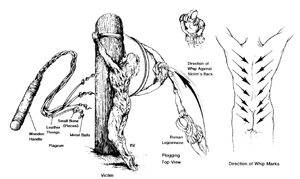
“Fig 2.Scourging. Left, Short whip (flagrum) with lead balls and sheep bones tied into leather thongs. Center left, Naked victim tied to flogging post. Deep stripelike lacerations were usually associated with considerable blood loss. Center right, View from above, showing position of lictors. Right, Inferomedial direction of wounds.
Scourging Practices
Flogging was a legal preliminary to every Roman execution, 28 and only women and Roman senators or soldiers (except in eases of desertion) were exempt.11 The usual instrument was a short whip (flagellum) with several single or braided leather thongs of variable lengths, in which small iron balls or sharp pieces of sheep bones were tied at intervals (Fig 2).5 ,7 ,11 Occasionally, staves also were used. 8 , 12 For scourging, the man was stripped of his clothing, and his hands were tied to an upright post (Fig 2). 11 The back, buttocks, and legs were flogged either by two soldiers (lictors) or by one who alternated positions.5, 7, ,28 The severity of the scourging depended on the disposition of the lictors and was intended to weaken the victim to a state just short of collapse or death. 8 > After the scourging, the soldiers often taunted their victim.
Medical Aspects of Scourging
As the Roman soldiers repeatedly struck the victim's back with full force, the iron balls would cause deep contusions, and the leather thongs and sheep bones would cut into the skin and Subcutaneous tissues.7 Then, as the flogging continued, the lacerations would tear into the underlying skeletal muscles and produce quivering ribbons of bleeding flesh.2 , 7 , 25 Pain and blood loss generally set the stage for circulatory shock.12 The extent of blood loss may well have determined how long the victim would survive on the cross.8
Scourging of Jesus
At the Praetorium, Jesus was severely whipped. (Although the severity of the scourging is not discussed in the four gospel accounts, it is implied in one of the epistles [1Peter 2:24]. A detailed word study of the ancient Greek text for this verse indicates that the scourging of Jesus was particularly harsh.33 ) It is not known whether the number of lashes was limited to 39, in accordance with Jewish law.5 The Roman soldiers, amused that this weakened man had claimed to be a king, began to mock him by placing a robe on his shoulders, a crown of thorns on his head, and a wooden staff as a scepter in his right hand.1 Next, they spat on Jesus and struck him on the head with the wooden staff.1 Moreover, when the soldiers tore the robe from Jesus' back, they probably reopened the scourging wounds.7
The severe scourging, with its intense pain and appreciable blood loss, most probably left Jesus in a pre-shock state. Moreover, hematidrosis had rendered his skin particularly tender. The physical and mental abuse meted out by the Jews and the Romans, as well as the lack of food, water, and sleep, also contributed to his generally weakened state. Therefore, even before the actual crucifixion, Jesus' physical condition was at least serious and possibly critical.”
In Mel Gibson’s fine film, THE PASSION, the scourging of Jesus is particularly harsh. Knowing from history that scourging was inhumanly awful, a question is asked: “Is there anything in the New Testament record that suggests that Jesus’ scourging was unusually harsh and worse than the scourging of the other two criminals on their crosses? That the body of Jesus was whipped more than the normal Roman “verbatio” that prepared a criminal for execution?”
A key line in the above article from Mayo clinic is: “A detailed word study of the ancient Greek text for this verse indicates that the scourging of Jesus was particularly harsh.” As I read this passage in Greek and English, I did not find that I Peter 2:24 emphasized that Jesus’ scourging was more harsh than the scourging of the other two criminals.
Read the following words from I Peter 2:24 and you determine if you think by reading these words in English that Jesus’ beating was “particularly harsh.” I Peter 2:24 says: “He himself bore our sins in his body on the cross, so that, free from sins, we might live for righteousness; by his wounds you have been healed.”
It is to be remembered that the severity of the scourging was not emphasized in the gospels. In fact, the Gospel of Mark (and therefore Matthew) report Jesus’ scourging in the passive tense e.g. “and having scourged Jesus.”
It is to be remembered that the Apostle Paul received flogging /scourging. See Acts 2:22-25, “The tribune ordered Paul to be brought into the barracks and ordered him to be examined by scourging” and II Corinthians11:25, “Five times I have received at the hands of the Jews forty lashes less one.”
There is verbal restraint in the Biblical accounts of the scourging and crucifixion. The word, “scourging,” occurs once in Mark and once in John. The Bible itself does not focus on the lurid and horrid details of Jesus’ scourging.
To get the lurid details of scourging, one must go to secular Roman history and cinematic imagination and recreation.
A similar restraint is found when the Bible describes the crucifixion. A description of Jesus being “nailed to the cross” or “nailing his hands and feet to the cross” is not found in the execution scene itself. Later, when Thomas doubted that Jesus was raised from the dead, he demanded to see to the nail wounds in Jesus’ hands and the spear mark in Jesus’ side. What Thomas saw was the wounds, not the nails pounding into human flesh on Good Friday. John’s gospel (which gives us an eyewitness) account does not describe nails being pounded into Jesus’ flesh.
The Bible exercises considerable restraint by not graphically describing the grimy details of Jesus’ scourging nor his crucifixion.
Having seen Mel Gibson’s film, THE PASSION, I found it to be emotionally and spiritually riveting. His film was a powerful work of art. When the film was finished, I knew that Jesus had died for the sins of the whole world, including mine. I knew that “by his stripes, we are healed.” I knew that that Jesus had suffered immeasurably, in ways that I could/cannot comprehend. When Jesus suffered beyond human imagination, he still loved and prayed for his enemies. His love was incomprehensible. When I saw his body dripping with blood, I understood more clearly the Eucharistic prayer, “This is my body given for you. This is my blood, shed for you.”
Knowing the Bible’s restraint in picturing the scourging and crucifixion, I still appreciated Gibson’s graphic presentation of the horrific suffering of Jesus. Through Gibson’s film, I encountered the Jesus of the cross, his teachings, his love, his death, his suffering,
Through Gibson’s film, I was amazed at its historical accuracy in most respects. Like all authors, Gibson had his biases e.g. the prominent role that he created for Mary the mother of Jesus. He also had his biases to cinematically emphasize the physical brutality of Jesus’ suffering. Previously, Gibson had portrayed physical brutality in his others films. As a director, he knows how to picture physical brutality. In spite of Gibson’s biases, I appreciated the film and its telling the story about Jesus in a new way. The movie was confronting, uncomfortable and downright painful.
Like almost everyone else, I felt cheated when the story came to the Resurrection. The heart of the Christian Easter message was swallowed up by the devastating execution of Good Friday. The scourging and crucifixion of Jesus was much more powerful than the victory and resurrection of Christ.
Gibson exaggerated violence in several scenes: the crow pecking out the eyes of the impenitent thief, the soldier stretching out Jesus’ arm on the cross and popping the shoulder so Jesus’ hand would fit over a hole in the cross. In the film, the cross of Christ was not a vertical post stuck in the ground but a Latin cross on which the body of Jesus was nailed. Then that Latin cross came banging down against the ground with Jesus’ body on it…twice, mind you. The scourging scenes were similarly reconstructed to have Jesus suggesting he could handle more punishment and the scourging then intensified.
All of these scenes are inaccurate in that they reveal a tendency to exaggerate physical violence. A question is: Why did Gibson have the need to exaggerated physical violence which was already present in the historical narrative? I personally believe it was because he has a genius within himself to portray graphic violence e.g. in the movie, BRAVE HEART.
I remember a description of another artist. It was said about him, “He was much better at describing winter than spring.” Gibson was far better at describing Good Friday than Easter Sunday.
Discussion Question:
Why do you think Mel Gibson's film, The Passion, exaggerated the violence of Good Friday?
|
- And they clothed him in a purple cloak. Purple was a sign of royalty. Caesar wore royal purple robes and so in a spirit of mockery, the soldiers covered Jesus with a purple cloak.
-And after twisting some thorns into a crown, they put it on him. This was the second part of the mockery. Caesar wore a laurel wreath for a crown.
In human imagination, we often want the crown of thorns to exhibit sharp, prickly spikes that are one – two inches in length. According to most scholars, that kind of thorn bush was hard to find in ancient Jerusalem. On the other hand, we know that thorn bushes can have shorter prickly spikes and those short prickly spikes can also be very painful. There were several species of prickly, thorny shrubs that could have been used for the crown of thorns.
Definition: zizyphus spina-christi
Source: Webster's Revised Unabridged Dictionary (1913)
Christ's-thorn \Christ's-thorn`\, n. (Bot.) One of several prickly or thorny shrubs found in Palestine, especially the Paliurus aculeatus , Zizyphus Spina-Christi, and Z. vulgaris . The last bears the fruit called jujube, and may be considered to have been the mostreadily obtainable for the Crown of Thorns.
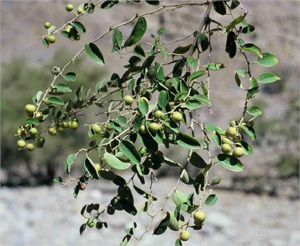
-And they began saluting him, ‘Hail, King of the Jews!’ The third mockery is greeting given to the Emperor, “Ave Caesar” or “Hail, the king of the Jews.”
-They struck his head with a reed, spat upon him, and knelt down in homage to him. The fourth mockery is kneeling before Jesus as if he were a king.
-After mocking him, they stripped him of the purple cloak and put his own clothes on him. The verses do not say that the soldiers stripped him of his crown. In popular art, we see Jesus’ crown of thorns still being worn during the crucifixion.
-Pilate went out again and said to them, ‘Look, I am bringing him out to you to let you know that I find no case against him.’ So Jesus came out, wearing the crown of thorns and the purple robe. The text is clear: Jesus was wearing the crown of thorns and purple robe.
-Pilate said to them, ‘Here is the man!’ The mood of the sentence is, “Look, here is your king.”
When the chief priests and the police saw him, they shouted, ‘Crucify him! Crucify him!’ In the movie, THE PASSION, the temple police and the Roman soldiers were clearly distinguished in dress and demeanor. Both groups were intensely and fanatically shouting for Jesus to be crucified.
- Pilate said to them, ‘Take him yourselves and crucify him; I find no case against him.’ Pilate is going to try to come off as innocent.
-The Jews answered him, ‘We have a law, and according to that law he ought to die because he has claimed to be the Son of God.’ This is the issue. Underline it. Highlight it. Emphasize it. “He has claimed to be the Son of God.” This is the real issue, but the Romans can’t execute Jesus for that, so the Jews (the chief priests) need to frame Jesus by saying that he is king in competition with Caesar.
-Now when Pilate heard this, he was more afraid than ever. We hear for the first time that Pilate was afraid. We hear that Pilate was afraid earlier but that he was more afraid when he heard the accusation that Jesus may be the Son of God. What was Pilate afraid of? Jesus? That Jesus might be divine? That Jesus might be the Son of God?
-He entered his headquarters again and asked Jesus, ‘Where are you from?’ Pilate knew that Jesus was from Galilee. This question is deeper than geography. Where do you come from Jesus? Above? From heaven? From God?
-But Jesus gave him no answer.
-Pilate therefore said to him, ‘Do you refuse to speak to me? Do you not know that I have power to release you, and power to crucify you?’
-Jesus answered him, ‘You would have no power over me unless it had been given you from above; therefore the one who handed me over to you is guilty of a greater sin.’ Jesus answers Pilate’s earlier question. That is, Jesus is suggesting that he, Jesus, has come “from above” and that Pilate would have no power over Jesus unless the God “above” had given him such power.
-From then on Pilate tried to release him, It is almost as if Pilate senses that Jesus is “from above” and Pilate does not want to mess around with the Divine Presence of God that is within Jesus.
-But the Jews cried out, ‘If you release this man, you are no friend of the emperor. Everyone who claims to be a king sets himself against the emperor.’ The Jewish leadership changes their charges from blasphemy to insurrection, and they know what they are doing. They falsely accuse Jesus of setting himself up as a competitor with Caesar even though Jesus has expressly denied it. Jesus knows that his kingdom is not of this world.
-When Pilate heard these words, he brought Jesus outside and sat on the judge’s bench at a place called The Stone Pavement, or in Hebrew Gabbatha. “Gabbatha, from the Aramaic or Hebrew meaning ridge, or height, with a practical meaning of the ridge of the house, or the temple-mound, was located in Jerusalem near the Fortress of Antonia, a palace / Roman military barracks, named after Mark Anthony (see Cleopatra ) by Herod The Great , which was connected to the Temple (see Temples ). Gabbatha was covered with a mosaic of colored stones, known in Greek as lithostroton, meaning stone-paved, and hence as "The Pavement." It was the custom of the Roman governors to conduct their tribunals in open areas, so a judgment seat was placed on this pavement outside the judgment-hall, or Praetorium .”
-Now it was the day of Preparation for the Passover;
-And it was about noon. The Bible says about “the sixth hour” which meant noon.
-He said to the Jews, ‘Here is your King!’ Circle the words, “your king.” Pilate caves into the crowd and announces that Jesus is “your king,” implying that Jesus was a threat to Caesar.
-They cried out, ‘Away with him! Away with him! Crucify him!’ It is not longer simply the chief priests and scribes who were accusing Jesus. Now, it is the masses, the crowd, the hysteria of the mob that could incite a riot.
-Pilate asked them, ‘Shall I crucify your King?’ Circle the words, “your king.” Pilate was taunting the crowds but also finding a way that he could absolve himself from guilt of falsely sentencing a man who he knew was innocent.
-The chief priests answered, ‘We have no king but the emperor.’ The chief priests were still a powerful presence in that crowd. They had been planning the execution of Jesus all along and now they were getting close to having the dirty deed done.
#341. Pilate Delivers Jesus to be Crucified
Matthew 27:24-26, Mark 15:15, Luke 23:24-25, John 19:16
We will focus our study on Matthew’s account of the story.
-So when Pilate saw that he could do nothing, but rather that a riot was beginning, Here was the motivation for Pilate. He needed to avoid a riot. Pilate experienced thirty-two riots during his term in office and he knew first hand how ugly a riot could be.
-He took some water and washed his hands before the crowd, This gesture has become symbolic for the human race. “Wash your hands” of the mess. By washing his hands, Pilate thought that he could wash his guilt and collusion away. He could not. History passed the verdict on Pilate: “Crucified under Pontius Pilate.” Washing hands or not, Pilate was guilty.
-Saying, ‘I am innocent of this man’s blood; see to it yourselves.’ What a pretense.
-Then the people as a whole answered, ‘His blood be on us and on our children!’ Underline. Highlight. This saying sparked a historical precedent that has lasted for centuries. For centuries, people have blamed the Jews and the children of the Jews for the death of Christ. People have used these famous words to support their prejudicial bigotry against the Jews.
One fascinating point in the movie, THE PASSION, was any omission of this famous line that has been used to legitimize prejudice against the Jews. Gibson was painstakingly faithful in trying to reproduce the exact Biblical lines from the gospel narrative. That Gibson chose to not include this line was ingenious from my perspective. If any line could have been included in the movie to substantiate prejudice against the Jews, this line could have been. Gibson chose to not include these famous words from the Bible and history. Some people have suggested that this famous line was originally included in the first showing of the movie, but after the initial showing of the film, there was such an uproar about the movie being anti-Semitic that Gibson removed that famous line from the final version of the movie. It seems that Gibson caved into the mob of reviewers who would not allow those incendiary words to be included in that famous movie. It wasn’t Gibson himself who wanted to omit those words but the reviewers in the crowds.
- So he released Barabbas for them;
-And having flogged Jesus, he handed him over to be crucified. Notice the passive tense in Mark (and therefore Matthew’s) account of the flogging/scourging. Mark does not dwell on a detailed description of Jesus’ scourging.
PAINTING AND IMAGINATION: JESUS WITH PILATE
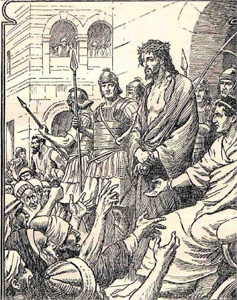
ALTIS
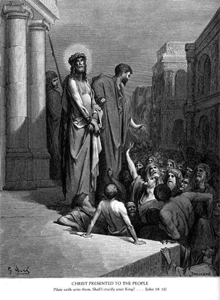
DORE
Notice in the Renaissance paintings below, their artists were more fascinated with the beauty of the human body than the suffering/flogging of Jesus of Nazareth. The artists were primarily interested in the beauty of the human body and the beauty of light and its shades, subtleties, and movement.
PAINTING AND IMAGINATION: THE FLOGGING
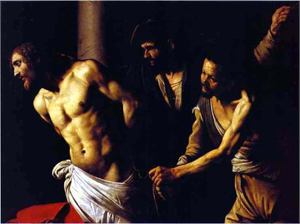
CARAVAGGIO - THE FLAGELLATION
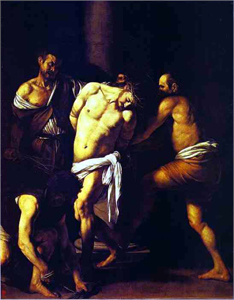
CARAVAGGIO
The painting below is almost antiseptic. There is no pain in the painting.
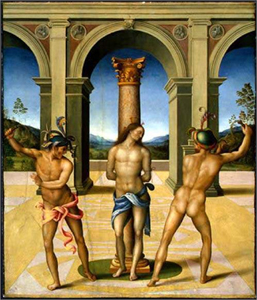
BACCIACHA - THE FLAGELLATION
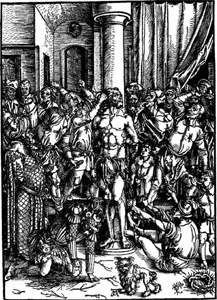
DURER - THE FLAGELLATION
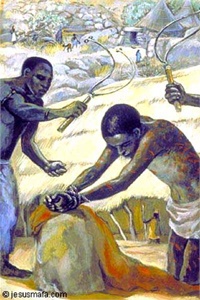
MAFA - THE FLAGELLATION
#343. The Road to Gogotha
Matthew 27:31b-32, Mark 15:20b-21, Luke 23:26-32, John 19:17a
-Then they led him out to crucify him. They compelled a passer-by, who was coming in from the country, to carry his cross. It was Simon of Cyrene, the father of Alexander and Rufus. Simon of Cyrene became a symbol of people who are willing to pick up the cross that life has given them. Earlier in his ministry, Jesus invited his true disciples to pick up their cross and follow him. Simon has become a symbol of a person who was willing to pick up the cross that life forced on him.
-“As Jesus was carrying his cross out of Jerusalem to the place of execution, a man named Simon of Cyrene was coming in ( Matthew 27:32; Mark 15:21; Luke 23:26 ), and the soldiers compelled him to carry the cross of Jesus. (The word angareuo (Greek gamma corresponds to English "ng" as in "finger"), here used for "compel," is a technical one, perhaps better translated "impress", and referring to the legal right of a soldier to require a provincial to carry his gear one mile for him. The word occurs in the New Testament only here and in Matthew 5:41.) Mark calls him "the father of Alexander and Rufus" without further explanation, apparently taking it for granted that his readers would all know who Rufus and Alexander are. The Christian writer Papias (died around 130) tells us that Mark originally wrote his Gospel for the Christian community in Rome. This suggests that Alexander and Rufus were well known to, and probably part of, a Christian congregation in Rome.”
PAINTING AND IMAGINATION: ON THE WAY TO GOLGOTHA

DURER
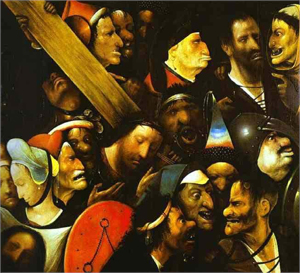
BOSCH
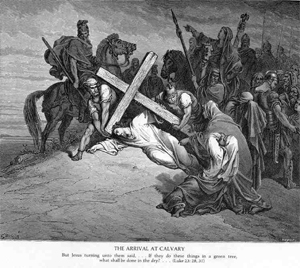
DORE
Notice the antiseptic quality of the next two modern American depictions of Jesus. While both JESUS OF NAZARETH and JESUS CHRIST SUPERSTAR were shocking for their decades in history, as we look back at these pictorial representations, they seem dreadfully anemic and antiseptic. In Zefirelli’s film, Jesus even has soft beautiful blue eyes. In the picture that advertised his film, Jesus has only a hint of blood on him from the thorns.
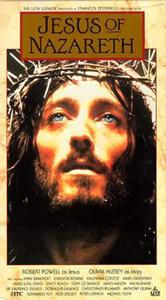
ZEFIRELLI
- A MODERN MOVIE
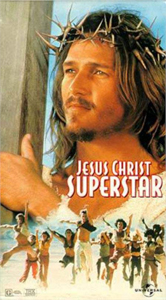
AN AMERICAN ROCK OPERA
Discussion Question:
What does Jesus' crucifixion on the cross mean to you? |

 Back to Top Back to Top
|















